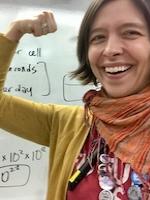
Event Information

After a brief introduction, participants will engage in the following authentic place-based, active learning experiences designed to help participants get a taste of the work our students do in their sit spots and "bring back" digitally to our classroom community:
- SOUNDSCAPE (10 min, including intro and debrief: 3 min listening, 2 min sketching, 2 min sharing): Listening to a digital recording of a place at night (https://www.youtube.com/watch?v=3TNK916Pjto), sketching an idea of what the landscape might look like, and sharing their ideas with a peer. Our students record their own soundscapes and complete this exercise with their own peers, comparing the sketches to the actual locations where the recordings were made.
- SHARE A STORY (7.5 min, including intro and debrief): Think about a story from a time you were outside. Share with a peer! Our students interview family members locally and (using digital tools) elders from around the world to learn more and share about how land use by people changes over time, as well as the meaning people make from their experiences outdoors.
- LIFE CYCLE TIMING (5 min), like when a tree buds or sheds its leaves: Participants will use a QR code to explore the USA National Phenology Network's Visualization Tool, then share with a peer what they notice in the map or graph they select. Students can document a tree at their sit spots over time and upload their data to this network's Nature's Notebook citizen/community science database. (USA-NPN is a federally funded project supported by agencies like NASA, the National Science Foundation, the Fish & Wildlife Service, the USDA, and more.)
Finally, we situate these practices in Native / Indigenous wisdom, highlighting how these digital practices not only build the 4Cs of 21st century learning but also align with knowledge that people have used and are using around the country to caretake our local environments.
Place-Based Social Studies Education: Learning from Flint, Michigan by Annie McMahon Whitlock (Teachers College Press, 2024).
The Power of Place by Tom Vander Ark, Emily Leibtag, and Nate McClennen (ASCD, 2020).
Place-Based Scientific Inquiry: A Practical Handbook for Teaching Outside by Benjamin Wong Blonder, Ja'Nya Banks, Austin Cruz, Anna Dornhaus, R. Keating Godfrey, Joshua S. Hoskinson, Rebecca Lipson, Pacifica Sommers, Christy Stewart, Alan Strauss (Routledge, 2023).Place-Based Social Studies Education: Learning from Flint, Michigan by Annie McMahon Whitlock (Teachers College Press, 2024).
The Power of Place by Tom Vander Ark, Emily Leibtag, and Nate McClennen (ASCD, 2020).
Place-Based Scientific Inquiry: A Practical Handbook for Teaching Outside by Benjamin Wong Blonder, Ja'Nya Banks, Austin Cruz, Anna Dornhaus, R. Keating Godfrey, Joshua S. Hoskinson, Rebecca Lipson, Pacifica Sommers, Christy Stewart, Alan Strauss (Routledge, 2023).


Participants will also be accessing the visualization tools at https://data.usanpn.org/vis-tool.